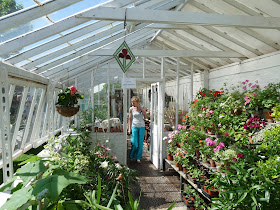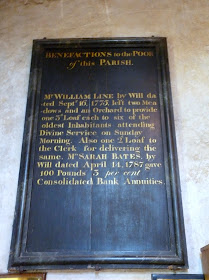Every year the National Gardens Scheme (NGS) gardens across
England and Wales welcome about 750,000 visitors. Most gardens which open for
the NGS are privately owned and open just a few times each year. Some gardens
open as part of a group with the whole community involved. The gardens give all
the money raised directly to us (including from the sale of teas and plants);
the only exceptions being in some cases they ask that a small proportion goes
to a nominated local charity.
This scheme now raises £2.5M a year for charity and was
originally founded in 1927 to pay for District Nurses who visited poor families
but this was no longer necessary when Labour founded the NHS in 1948 and the
District Nurse function was absorbed. So now this scheme taps into two very
English traits, helping the community and celebrating the joy and pleasure of
gardening. It also plugs into another trait, voyeurism or the joy of seeing how
others live!
Now here in Buckinghamshire we are lucky to have some lovely
countryside indeed. The Chilterns Hills lay only a few miles north-west of
London and yet they are an unspoilt area of rolling chalk hills, magnificent
beech woods, quiet valleys and charming brick and flint villages. It provides a
wonderful mosaic of woods, fields, hedges, sunken lanes and clear streams.
Within this area, the adjoining Vale of Aylesbury and the
beautiful bluffs along the Thames you will find many country mansions with
magnificent gardens but today I concentrate on more humble and in a way more
satisfying gardens open under the NGS, those of our neighbours in Aylesbury,
Wendover and Little Missenden. More humble and satisfying because they are
attainable gardens in ordinary (largely!) houses which we feel we could do
ourselves if we had the energy, green fingers and the occasional spark of
genius. We went to see these over two
weekends recently.
 |
| Victorian Greenhouse |
 |
| Spenser Road, Aylesbury, the story of the garden |
Firstly the Aylesbury Gardens. Set close together on the
South side of Aylesbury off the Wendover and Tring Roads these were four
ordinary suburban gardens made special by their owner’s dedication. These
mature town gardens showed a wide range of ideas and designs. Each garden
displayed the individuality of its owners and their passions, including tender
perennials, herbaceous borders and ponds as well as a new 'wildlife' pond.
Other features include an interesting Victorian greenhouse, vegetable beds and
cottage style gardens. The Victorian greenhouse was all that was left of a once
larger range and these were common in the area as Aylesbury Vale was an
important Market Garden supplying London with Plums, Greengages and the famous
Aylesbury Duck.
The Paddocks Wendover is tucked into a close beside the
Wendover Arm of the Grand Canal and was a small, peaceful garden with mixed
borders of colourful perennials, and a special show of over 70 varieties of
scented 'David Austin' roses. The delphiniums, all 'Blackmore and Langdon'
named varieties give a spectacular show. Many are over 2m. tall. Some areas are
colour themed, and the white garden with its secluded arbour, was created for
the BBC and named 'The Magic of Moonlight'. There is a cool hosta walk, and a
begonia 'wall'. The garden featured in 'Love your Garden' with Alan Titchmarsh
in the programme about 'The Rose Garden'
 |
| Wendover Arm |
The Wendover Arm of the Grand Union Canal provides a scenic
and tranquil route from Bulbourne to Wendover - built as a feeder to provide
much needed water to the Tring summit on the Grand Union. For a small additional cost the canal was made
navigable and opened in 1797. Unfortunately it soon suffered from leakage and
by 1870 the equivalent of over 30 locks per day in water was being lost. Despite
many attempts to stop these leaks, the canal was closed to traffic in 1897 and
stop planks were installed at Little Tring. The Arm was permanently closed in
1904 and the water diverted by a pipeline running under the dry bed of the
canal. Today it provides a lovely amenity walk and wildlife reserve which goes
into the centre of Wendover at Wharf Road. Literally a backwater it is a lovely
wildlife reserve and at its basin at Wendover it is still fed by the springs
which were the reason for its building to supply water to the Grand Canal which
goes from London to Birmingham and is the main highway (albeit at 5 mph!) of
the English Canal system.
Little Missenden village is one of the treasures of Bucks and
often features in Midsomer Murders and as a movie backdrop. Bypassed by the
main road it straggles along the wonderful chalk stream, the River Misbourne. The
Misbourne is one of the Chiltern chalk streams, a globally rare wildlife
habitat. Water emerges from the chalk as springs to feed the stream. In summer
little rain percolates into the chalk and the head of the river moves down its
valley. But in winter, if rainfall is heavy, the river starts flowing higher
up. Some of the gardens we were to visit here have the river flowing through
them as does the centre of the village (along with the Crown) the 17th
Century Red Lion Pub which also features the part time village shop where you
can ring in special orders during the week and pick them up at the weekend.
 |
| The Red Lion, Little Missenden |
The Saxon parish church of St John the Baptist is the oldest
building in the village. The church was extended in several stages for at least
1000 years, the oldest part being built in circa 975 AD. The chancel dates to
the 13th century, the North chapel was added in the 14th century, and the porch
the following century. The exterior of the south aisle was rebuilt in brick in
the 18th century. Some wall paintings survive inside the church, which were
uncovered in 1931. The best preserved of these is a 13th-century depiction of
St Christopher with a young Jesus.
 |
| Church of St. John the Baptist, Little Missenden 975 AD |
The village has an early seventeenth-century manor, with a
southern exterior dating to the late seventeenth century. The manor still has
its original staircase. Missenden House is a red/grey brick building dated
1728. Little Missenden Abbey is a neo-Tudor structure built by William Howard
Seth-Smith I.
Before the arduous task of inspecting the six gardens open
to the public we first took cream tea in the church grounds enjoying the
excellent cake fresh baked by the parishioners with all the funds going to the
upkeep of this wonderful old church. Then a wander around its atmospheric
interior with its 13th Century wall paintings which somehow survived
the ravages of the reformation (they were whitewashed), its wonderful stained
glass, monuments to the great and good of the parish and last, but not least,
the charitable bequests for the deserving poor. One of these promised if you
were poor, of good morals and attended on a Sunday you would be entitled to a
loaf of bread!
Today we were able to visit a variety of gardens set in this
attractive Chiltern village in an area of outstanding natural beauty. You can
start off at one end of the village and wander through stopping off half way
for tea at the beautiful Anglo-saxon church built in 975. The gardens vary from
a small cottage garden by the R Misbourne to large gardens. The gardens reflect
different style houses from several old cottages, a Mill House, more modern
houses to a converted barn. There are herbaceous borders, shrubs and trees, old
fashioned roses, hostas, topiary, koi and lily ponds, collection of conifers
and kitchen gardens. Some gardens are highly colourful; others are just green
and peaceful.
 |
| Mill House, Little Missenden - The chimney built when the mill was converted from water to steam |
 |
| River Missbourne |
 |
| Two Ducks |
Our horticultural curiosity sated we slunk home and decided,
having changed the West Garden of Castle Caldwell, to a low maintenance
operation we would not be joining in the National Garden Scheme any day soon!
For more on the Chilterns see “Chiltern Hundreds and
Buckinghamshire” in our Blog sidebar on the right;
For more on Gardens see “Hortus Praetorius” in our Blog
sidebar on the right;
For details of the NGS and gardens open near you check out
their website;
http://www.ngs.org.uk/
http://www.ngs.org.uk/





































What lovely gardens! And enjoying them in the sunshine is an added bonus, isn't it? I love the Chilterns.
ReplyDeleteYes MuMu, in summer it is God's own country around here - you must let me show you and the kids the sights!
ReplyDelete